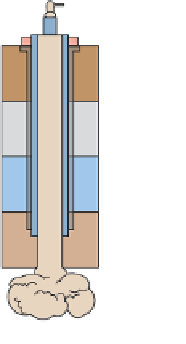Environmental Engineering Reference
In-Depth Information
T rade-Offs
T rade-Offs
Phytoremediation
Deep Underground Wells
Advantages
Disadvantages
Advantages
Disadvantages
Easy to establish
Slow (can take
several growing
seasons)
Safe method if
sites are chosen
carefully
Leaks or spills at
surface
Leaks from
corrosion of well
casing
Inexpensive
Wastes can be
retrieved if
problems
develop
Effective only at
depth plant roots
can reach
Existing fractures
or earthquakes
can allow wastes
to escape into
groundwater
Can reduce
material dumped
into landfills
Easy to do
Encourages
waste production
Some toxic organic
chemicals may
evaporate from plant
leaves
Low cost
Produces little air
pollution compared
to incineration
Figure 17-17
Trade-offs:
advantages and disadvantages of
injecting liquid hazardous wastes into deep underground wells.
Critical thinking: pick the single advantage and disadvantage
that you think are the most important.
Some plants can
become toxic to
animals
Low energy use
T rade-Offs
Surface Impoundments
Figure 17-16
Trade-offs:
advantages and disadvantages of
using
phytoremediation
to remove or detoxify hazardous waste.
Critical thinking: pick the single advantage and disadvantage
that you think are the most important.
Advantages
Disadvantages
Low construction
costs
Groundwater
contamination
from leaking liners
(or no lining)
air pollutants such as toxic dioxins and produces a
highly toxic ash that must be safely and permanently
stored.
Most hazardous waste in the United States is
disposed of on land in deep underground wells; sur-
face impoundments such as ponds, pits, or lagoons;
and state-of-the-art landfills. In
deep-well disposal,
liq-
uid hazardous wastes are pumped under pressure
through a pipe into dry, porous geologic formations or
zones of rock far beneath the aquifers tapped for
drinking and irrigation water. Theoretically, these
liquids soak into the porous rock material and are iso-
lated from overlying groundwater by essentially im-
permeable layers of rock.
Figure 17-17 lists the advantages and disadvan-
tages of deep-well disposal of liquid hazardous
wastes. Many scientists believe that current regula-
tions for deep-well disposal are inadequate and should
be improved.
Low operating
costs
Air pollution from
volatile organic
compounds
Can be built
quickly
Overflow from
flooding
Wastes can be
retrieved if
necessary
Disruption and
leakage from
earthquakes
Can store wastes
indefinitely with
secure double
liners
Promotes waste
production
Figure 17-18
Trade-offs:
advantages and disadvantages of
storing liquid hazardous wastes in surface impoundments.
Critical thinking: pick the single advantage and disadvantage
that you think are the most important.
Surface impoundments
are excavated depressions
such as ponds, pits, or lagoons into which liquid haz-
ardous wastes are drained and stored (Figure 11-26,
p. 258). As water evaporates, the waste settles and
becomes
x
H
OW
W
OULD
Y
OU
V
OTE
?
Do the advantages of deep-well
disposal of hazardous waste from soil and water outweigh
the disadvantages? Cast your vote online at http://biology
.brookscole.com/miller11.
more
concentrated.
Figure
17-18
lists
the







































































